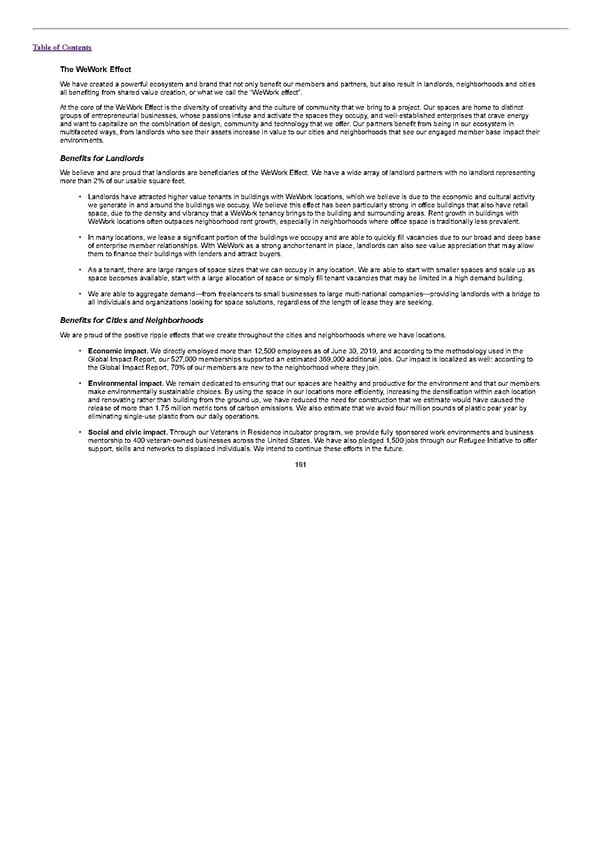Table of Contents The WeWork Effect We have created a powerful ecosystem and brand that not only benefit our members and partners, but also result in landlords, neighborhoods and cities all benefiting from shared value creation, or what we call the “WeWork effect”. At the core of the WeWork Effect is the diversity of creativity and the culture of community that we bring to a project. Our spaces are home to distinct groups of entrepreneurial businesses, whose passions infuse and activate the spaces they occupy, and well-established enterprises that crave energy and want to capitalize on the combination of design, community and technology that we offer. Our partners benefit from being in our ecosystem in multifaceted ways, from landlords who see their assets increase in value to our cities and neighborhoods that see our engaged member base impact their environments. Benefits for Landlords We believe and are proud that landlords are beneficiaries of the WeWork Effect. We have a wide array of landlord partners with no landlord representing more than 2% of our usable square feet. • Landlords have attracted higher value tenants in buildings with WeWork locations, which we believe is due to the economic and cultural activity we generate in and around the buildings we occupy. We believe this effect has been particularly strong in office buildings that also have retail space, due to the density and vibrancy that a WeWork tenancy brings to the building and surrounding areas. Rent growth in buildings with WeWork locations often outpaces neighborhood rent growth, especially in neighborhoods where office space is traditionally less prevalent. • In many locations, we lease a significant portion of the buildings we occupy and are able to quickly fill vacancies due to our broad and deep base of enterprise member relationships. With WeWork as a strong anchor tenant in place, landlords can also see value appreciation that may allow them to finance their buildings with lenders and attract buyers. • As a tenant, there are large ranges of space sizes that we can occupy in any location. We are able to start with smaller spaces and scale up as space becomes available, start with a large allocation of space or simply fill tenant vacancies that may be limited in a high demand building. • We are able to aggregate demand—from freelancers to small businesses to large multi-national companies—providing landlords with a bridge to all individuals and organizations looking for space solutions, regardless of the length of lease they are seeking. Benefits for Cities and Neighborhoods We are proud of the positive ripple effects that we create throughout the cities and neighborhoods where we have locations. • Economic impact. We directly employed more than 12,500 employees as of June 30, 2019, and according to the methodology used in the Global Impact Report, our 527,000 memberships supported an estimated 369,000 additional jobs. Our impact is localized as well: according to the Global Impact Report, 70% of our members are new to the neighborhood where they join. • Environmental impact. We remain dedicated to ensuring that our spaces are healthy and productive for the environment and that our members make environmentally sustainable choices. By using the space in our locations more efficiently, increasing the densification within each location and renovating rather than building from the ground up, we have reduced the need for construction that we estimate would have caused the release of more than 1.75 million metric tons of carbon emissions. We also estimate that we avoid four million pounds of plastic pear year by eliminating single-use plastic from our daily operations. • Social and civic impact. Through our Veterans in Residence incubator program, we provide fully sponsored work environments and business mentorship to 400 veteran-owned businesses across the United States. We have also pledged 1,500 jobs through our Refugee Initiative to offer support, skills and networks to displaced individuals. We intend to continue these efforts in the future. 161
 S1 - WeWork Prospectus Page 184 Page 186
S1 - WeWork Prospectus Page 184 Page 186